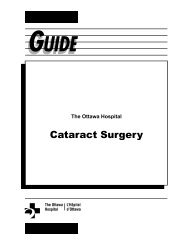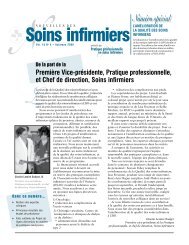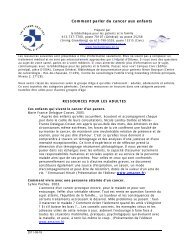You also want an ePaper? Increase the reach of your titles
YUMPU automatically turns print PDFs into web optimized ePapers that Google loves.
<strong>Ottawa</strong> Regional<br />
WOMEN’S BREAST HEALTH CENTRE<br />
<strong>What</strong> <strong>is</strong> a <strong>Cyst</strong>?<br />
WB1 (Rev 10/2006)<br />
“A Partner in Breast Health”<br />
THE OTTAWA HOSPITAL – CIVIC CAMPUS<br />
Grimes Lodge, 5th Floor<br />
200 Melrose Avenue, <strong>Ottawa</strong>, Ontario<br />
Canada K1Y 4K7<br />
Tel: (613)761-4400 Fax: (613)761-4405<br />
<strong>What</strong> <strong>is</strong> a <strong>Cyst</strong>?<br />
A cyst <strong>is</strong> a fluid filled sac which typically<br />
occurs in women from their mid-thirties<br />
to their mid-fifties. It <strong>is</strong> a benign process<br />
which <strong>is</strong> not harmful to women. <strong>Cyst</strong>s<br />
can appear quite suddenly and are often<br />
tender. <strong>The</strong>y may present as a lump in a<br />
woman’s breast.<br />
Why do <strong>Cyst</strong>s Occur?<br />
As women age, the secretions normally<br />
found in the ducts of the breast become<br />
thicker. <strong>The</strong> narrow walls of the ducts<br />
may then block. As fluid builds up, the<br />
walls of the duct expand to form a round<br />
smooth sac.<br />
Deep<br />
<strong>Cyst</strong><br />
Shallow<br />
<strong>Cyst</strong><br />
How are <strong>Cyst</strong>s Treated?<br />
It <strong>is</strong> not necessary to aspirate all cysts, as<br />
they are harmless. <strong>Cyst</strong>s can be treated by<br />
having the fluid aspirated or withdrawn<br />
with a small needle. Usually the cyst will<br />
then collapse and d<strong>is</strong>appear. Th<strong>is</strong> provides<br />
confirmation that it <strong>is</strong> indeed a cyst. <strong>The</strong><br />
fluid can range in colour from green to<br />
milky brown. A dec<strong>is</strong>ion to aspirate <strong>is</strong><br />
often made after a d<strong>is</strong>cussion between the<br />
physician and the patient.<br />
Some women may have one or two cysts<br />
in their lifetime while other women may<br />
develop many. <strong>Cyst</strong>s do not put women at<br />
a higher r<strong>is</strong>k for breast cancer. Any lump<br />
that a woman finds in her breast should<br />
always be investigated by a physician.<br />
vvv<br />
If you have other questions or concerns<br />
that have not been answered here, please<br />
feel free to ask our staff.
CENTRE DE SANTÉ DU SEIN DE LA FEMME<br />
de la région d’<strong>Ottawa</strong><br />
« Partenaire pour la santé du sein »<br />
Qu’est-ce qu’un kyste?<br />
L’HÔPITAL D’OTTAWA – CAMPUS CIVIC<br />
Pavillon Grimes, 5 e étage<br />
200, avenue Melrose, <strong>Ottawa</strong> (Ontario)<br />
Canada K1Y 4K7<br />
Tél: (613)761-4400 Téléc: (613)761-4405<br />
Qu'est-ce qu'un kyste?<br />
Un kyste est une cavité rempli de liquide<br />
qui survient habituellement chez les<br />
femmes âgées d'environ 35 ans à 55<br />
ans. Ils représentent un processus bénin<br />
sans effet nu<strong>is</strong>ible. Les kystes peuvent<br />
apparaître très soudainement et sont<br />
souvent sensibles au toucher. Ils peuvent<br />
se présenter sous la forme d'un nodule ou<br />
d'une bosse au sein.<br />
Pourquoi les kystes se développent-ils?<br />
Quand les femmes vieill<strong>is</strong>sent, les<br />
sécrétions qui se trouvent normalement<br />
dans les canaux des seins deviennent<br />
plus épa<strong>is</strong>ses. Ces canaux étroits peuvent<br />
alors se bloquer. Au fur et à mesure que<br />
le liquide s'accumule, les paro<strong>is</strong> du canal<br />
se dilatent et forment une poche arrondie<br />
et l<strong>is</strong>se.<br />
Kyste<br />
profond<br />
Kyste<br />
superficiel<br />
Comment traite-t-on les kystes?<br />
Il n'est pas toujours nécessaire<br />
d'aspirer le liquide contenu dans les<br />
kystes, pu<strong>is</strong>que ceux-ci ne présentent<br />
aucun danger. On peut traiter les<br />
kystes en aspirant le liquide ou en le<br />
retirant à l'aide d'une petite aiguille.<br />
Habituellement, le kyste s'affa<strong>is</strong>se et<br />
d<strong>is</strong>paraît par la suite, ce qui permet de<br />
confirmer qu'il s'agit bien d'un kyste. La<br />
couleur du liquide peut varier du vert<br />
à un brun laiteux. La déc<strong>is</strong>ion d'aspirer<br />
le liquide est souvent pr<strong>is</strong>e à l'occasion<br />
d'une d<strong>is</strong>cussion entre le médecin et la<br />
patiente.<br />
Certaines femmes peuvent présenter un<br />
ou deux kystes durant leur vie, alors que<br />
d'autres peuvent en avoir beaucoup. La<br />
présence de kystes n'augmente pas le<br />
r<strong>is</strong>que de cancer du sein. Tout nodule<br />
qui se développe dans un sein devrait<br />
être examiné par le médecin.<br />
vvv<br />
Si vous avez d'autres questions ou<br />
préoccupations qui n'ont pas été<br />
abordées ci-dessus, n'hésitez pas à en<br />
parler à notre personnel.













